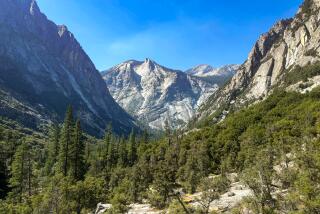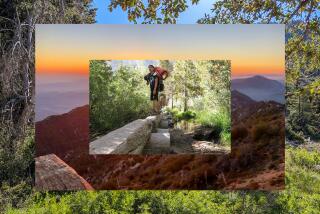Alternatives to Yosemite Are Right in Your Backyard
- Share via
Mother Nature gave Yosemite a severe winter, but it’s the accommodation of Mr. and Mrs. America that is likely to make it a troublesome summer.
In the aftermath of massive January flooding damage to Yosemite Valley and other parts of California’s most-visited national park, Park Service officials are scrambling to devise a system that reopens popular park areas in time for the summer crush, but also limits visitor access. (Yosemite gets more than 4 million visitors a year.) The leading prospect is a plan requiring reservations from every visitor, not just those who plan to spend the night. Officials say the system could go into effect as soon as May.
Although rangers say they’re aiming for a limited reopening of Yosemite Valley on March 15, none of the valley’s former 780 campsites will be open until sometime later, and at least two campgrounds are targeted for closure. Concessionaire spokesman Keith Walklet says that about 250 of the park’s roughly 1,500 lodging units (in Yosemite Lodge) won’t reopen at all, and that timing is uncertain for reopening of the rest. (Park information is available at [209] 372-0200.)
All these limits and uncertainty are good reasons for travelers to remember that Yosemite is not this state’s only national park. Yosemite park spokeswoman Christine Cowles puts it this way: “It’s not a bad time to start looking at other options.”
Here, sticking to national parks within this state, are six. (Campsite reservations at many of the parks are handled by Destinet; telephone [800] 365-2267).
* Channel Islands National Park. A reminder of what raw coastal Southern California looked like. The park covers five islands, the closest is 14 miles off the coast of Ventura. Visitors hike, camp, snorkel, dive, kayak, picnic, and watch birds and other wildlife. The park information center in Ventura counted about 490,000 visitors last year, but most of them never made it out to the islands themselves. Islands are busiest in August, according to surveys by the National Park Foundation. Visitor Center: 1901 Spinnaker Drive, Ventura (tel. [805] 658-5730). Main concessionaire, providing transport to all five islands, is Island Packers, 1867 Spinnaker Drive, Ventura (tel. [805] 642-1393).
* Death Valley National Park. This is some of the world’s hottest, most barren and inhospitable terrain--but for many, its dunes, peaks, dry lake bed and abandoned mines are irresistible, especially amid spring wildflowers. About 300 miles east of Los Angeles. Hotel rooms, cabins and campsites available, with most activity clustered around Furnace Creek Visitor Center (tel. [619] 786-2331). About 1.2 million visitors last year, busiest in April.
* Joshua Tree National Park. About 140 miles east of Los Angeles, this preserve is actually the intersection of two deserts, the Mojave and the Colorado. Like Death Valley it was upgraded from national monument to national park status in 1994. Aside from campsites, the nearest lodging is three miles from the park’s north entrance in the town of Twentynine Palms. The park visitor center (tel. [619] 367-7511) is also in Twentynine Palms. About 1.1 million visitors last year, busiest in April.
* Lassen Volcanic National Park. About 50 miles east of Redding in northernmost California, this volcanic area is known for deep snows that keep its main road closed most of the year, thick pine forests, placid Manzanita Lake, the dramatic devastation from Lassen Peak’s last eruption in 1914 and the bursts of geothermal steam that persist year-round. Hiking, cross-country skiing. Aside from campsites and 19 lodging rooms at rustic Drakesbad Guest Ranch (June-October) within the park, nearest hotels and motels are in the neighboring towns of Mineral (about 10 miles south of the park entrance) and Chester (35 miles from the park’s south end). Park visitor center (tel. [916] 595-4444) is in Mineral. About 350,000 visitors last year; busiest in September.
* Redwood National Park. The sequoias here in coastal Northern California are known as the world’s tallest trees. Also, the three drive-through trees that once were icons of California tourism are all in this neighborhood, along U.S. 101. Visitors hike, look for elk, admire seascapes, tide pools and those tall trees. The park, which reaches to within 60 miles of the Oregon border, is served by year-round visitor centers in Crescent City (at its north end) and Orick (to the south). The park’s main phone number for visitors is (707) 464-6101. Aside from campsites and a hostel, nearest lodgings are in Crescent City, Klamath and Orick. About 425,000 visitors last year; busiest in July.
* Sequoia and Kings Canyon National Parks. They’re two parks, but they lie next to each other among the mountains and foothills of the Sierra, and are administered as a single 863,700-acre unit. The parks’ main visitor center near Three Rivers (tel. [209] 565-3341) is about 230 miles north of Los Angeles, a four- to five-hour drive. Kings Canyon, too, suffered serious flooding. Rangers say this year’s opening could be delayed until as late as June.
The parks include campsites, cabins and two motels, with more rooms in Three Rivers. For lodging reservations and information, call (209) 335-5500. About 840,000 visitors to Seqouia last year and 500,000 to Kings Canyon, busiest in August.
Reynolds travels anonymously at the newspaper’s expense, accepting no special discounts or subsidized trips. He welcomes comments and suggestions, but cannot respond individually to letters and calls. Write Travel Insider, Los Angeles Times, Times Mirror Square, Los Angeles 90053 or e-mail [email protected].
More to Read
Sign up for The Wild
We’ll help you find the best places to hike, bike and run, as well as the perfect silent spots for meditation and yoga.
You may occasionally receive promotional content from the Los Angeles Times.







